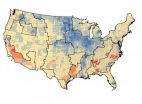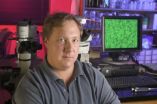(Press-News.org) When we make plans that will change a natural environment — whether it's building a new shopping mall or planting a new forest — surveyors dutifully assess the environmental risks to plant and animal life in the region. But what's environmentally good for one area may be an environmental disaster for an adjacent one, a Tel Aviv University researcher cautions.
When displaced by these projects, indigenous species migrate to neighboring habitats, says Guilad Friedemann, a PhD student at TAU's Department of Zoology in the George S. Wise Faculty of Life Sciences. This has a significant impact on the species and resources that were already there. With a new species moving in and demanding its share of existing space and food, competition becomes fierce.
Based on a study of two raptor species in the Judean Foothills, the long-legged buzzard and the short-toed eagle, Friedemann has determined that human interference in natural habitats has a reach beyond the specific region under assessment. Pursued under the supervision of TAU's Prof. Yossi Leshem and Prof. Ido Izhaki from the University of Haifa, and in collaboration with the KKL-JNF, Smolar – Vinnikov Foundation, NPA and Kfar Etzion Field School, this ongoing research has been published in the journal Biological Conservation.
A turf war revealed by GPS
When a species is forced from its habitat, it has to go somewhere — and that has an effect on neighboring environments. The long-legged buzzard had always made its home in the open spaces of the Judean Mountains, explains Friedemann, using the mountain cliffs for nesting and hunting. But because environmentalists have been planting a new forest in the area in a process known as "afforestation," the buzzard needed to migrate elsewhere. They now make their nests in the trees of the Judean Foothills, threatening the nesting ground and food source of the short-toed eagle, its established inhabitants.
Through extensive field research, including the placement of advanced GPS systems on the adult nesting birds, Friedemann and his fellow researchers tracked the movements of both species throughout breeding season by tagging four buzzards and three eagles. They found 31 buzzard nests and 60 eagle nests in the Judean Foothills. The researchers continue to examine each nest twice a season, tracking the growth of new chicks and analyzing food remains to determine the extent of competition for food sources between the two raptor species.
The results, say Friedemann, will indicate that the buzzards have started to muscle in on the eagles' habitat — taking over their nests and diminishing the common food supply of snakes, lizards and rodents. "Every time you have strong competition between two species, one is more successful," he explains. "There is a negative impact on the weaker species."
The next step, says Friedemann, is to extend research done with the GPS transmitters, and to assess the rising levels of aggression in both buzzards and eagles, which arise from the heightened competition for food and space. By playing recorded bird calls near nesting sites of the opposite species, the researchers can measure how aggressive the response becomes.
Living side-by-side
In this case, afforestation, usually considered a positive contribution to the sustainability of our environment, was the cause of habitat destruction. This should serve as a cautionary lesson for any project that serves to alter the natural environment, the researchers conclude.
"There needs to be a broader consideration not just of the directly affected area, but of neighboring areas as well — especially if there is a species that will be forced to abandon the original area and seek out a new place to live," Friedemann says. In this instance, harm might have been avoided by setting aside a track of open space where the buzzards could continue to nest and hunt, a conclusion that would have broad implications for landscape planning and policy.
We must take more responsibility for the assessment of neighboring habitats, Friedemann cautions, because what helps one environment might harm the next.
INFORMATION:
American Friends of Tel Aviv University (www.aftau.org) supports Israel's leading, most comprehensive and most sought-after center of higher learning. Independently ranked 94th among the world's top universities for the impact of its research, TAU's innovations and discoveries are cited more often by the global scientific community than all but 10 other universities.
Internationally recognized for the scope and groundbreaking nature of its research and scholarship, Tel Aviv University consistently produces work with profound implications for the future.
Raptor usurpers in neighboring habitats reshape the conventional wisdom
Environmental assessments need to examine a broader reach, says Tel Aviv University researcher
2011-08-04
ELSE PRESS RELEASES FROM THIS DATE:
Getting to the heart of the appeal of video games
2011-08-04
People spend 3 billion hours a week playing videogames but little is known scientifically about why they are actually fun in the first place.
The vast majority of research into videogames has concentrated on the possible harmful effects of playing videogames, ignoring the simple question of why people actually want to play them.
But new research led by scientists at the University of Essex sheds some light on the appeal of videogames and why millions of people around the world find playing them so much fun.
The study investigated the idea that many people enjoy playing ...
UI biologist finds one species of pathogen can produce two distinct biofilms
2011-08-04
Many medical devices, ranging from artificial hip joints to dentures and catheters, become sites for unwelcome guests -- complex communities of microbial pathogens called biofilms that are resistant to the human immune system and antibiotics, thus proving a serious threat to human health.
However, researchers may have a new way of looking at biofilms, thanks to a study conducted by University of Iowa biologist David Soll and his colleagues published in the Aug. 2 issue of the online, open access journal PLoS Biology.
Previously, researchers believed that each pathogen ...
USDA scientists study effects of rising carbon dioxide on rangelands
2011-08-04
This press release is available in Spanish.
Rising carbon dioxide (CO2) levels can reverse the drying effects of predicted higher temperatures on semi-arid rangelands, according to a study published today in the scientific journal Nature by a team of U.S. Department of Agriculture (USDA) and university scientists.
Warmer temperatures increase water loss to the atmosphere, leading to drier soils. In contrast, higher CO2 levels cause leaf stomatal pores to partly close, lessening the amount of water vapor that escapes and the amount of water plants draw from soil. ...
Mayo Clinic examines why knee osteoarthritis afflicts more women than men
2011-08-04
JACKSONVILLE, Fla. — A Mayo Clinic orthopedic surgeon suspects that the nagging pain and inflammation that women can experience in their knees may be different from what men encounter, and she has been chosen to lead a novel U.S.-Canadian study to explore the question. The Society for Women's Health Research (SWHR) and its Interdisciplinary Studies in Sex-Differences (ISIS) Network on Musculoskeletal Health has awarded a group of researchers a $127,000 grant to lead a pilot project to understand whether biological differences between men and women affect the incidence and ...
Carbon hitches a ride from field to market
2011-08-04
RICHLAND, Wash. – Today, farming often involves transporting crops long distances so consumers from Maine to California can enjoy Midwest corn, Northwest cherries and other produce when they are out of season locally. But it isn't just the fossil fuel needed to move food that contributes to agriculture's carbon footprint.
New research published in the journal Biogeosciences provides a detailed account of how carbon naturally flows into and out of crops themselves as they grow, are harvested and are then eaten far from where they're grown. The paper shows how regions that ...
'Watermark ink' device identifies unknown liquids instantly
2011-08-04
Cambridge, Mass. - August 3, 2011 - Materials scientists and applied physicists collaborating at Harvard's School of Engineering and Applied Sciences (SEAS) have invented a new device that can instantly identify an unknown liquid.
The device, which fits in the palm of a hand and requires no power source, exploits the chemical and optical properties of precisely nanostructured materials to distinguish liquids by their surface tension.
The finding, published in the Journal of the American Chemical Society (JACS), offers a cheap, fast, and portable way to perform quality ...
UGA researchers use gold nanoparticles to diagnose flu in minutes
2011-08-04
Arriving at a rapid and accurate diagnosis is critical during flu outbreaks, but until now, physicians and public health officials have had to choose between a highly accurate yet time-consuming test or a rapid but error-prone test.
A new detection method developed at the University of Georgia and detailed in the August edition of the journal Analyst, however, offers the best of both worlds. By coating gold nanoparticles with antibodies that bind to specific strains of the flu virus and then measuring how the particles scatter laser light, the technology can detect influenza ...
GEN reports on nanotechology's impact on mass spectrometry
2011-08-04
New Rochelle, NY, August 3, 2011—A move toward smaller and smaller sample sizes is leading to a new generation of mass spectrometry instrumentation, reports Genetic Engineering & Biotechnology News (GEN). From a specific application point of view, novel nanoflow separation methodologies are ramping up the speed and precision with which scientists are able to validate biomarkers, according to the August issue of GEN (www.genengnews.com/gen-articles/nanoliter-volumes-push-ms-to-new-lows/3741).
"Basing biomarker validation on more sophisticated mass spec tools could help ...
Researchers develop and test new molecule as a delivery vehicle to image and kill brain tumors
2011-08-04
RICHMOND, Va. (Aug. 3, 2011) – A single compound with dual function – the ability to deliver a diagnostic and therapeutic agent – may one day be used to enhance the diagnosis, imaging and treatment of brain tumors, according to findings from Virginia Commonwealth University and Virginia Tech.
Glioblastomas are the most common and aggressive brain tumor in humans, with a high rate of relapse. These tumor cells often extend beyond the well-defined tumor margins making it extremely difficult for clinicians and radiologists to visualize with current imaging techniques. Researchers ...
New study calls into question reliance on animal models in cardiovascular research
2011-08-04
Anyone who follows science has read enthusiastic stories about medical breakthroughs that include the standard disclaimer that the results were obtained in mice and might not carry over to humans.
Much later, there might be reports that a drug has been abandoned because clinical trials turned up unforeseen side effects or responses in humans. Given the delay, most readers probably don't connect the initial success and the eventual failure.
But Igor Efimov, PhD, a biomedical engineer at Washington University in St. Louis who studies the biophysical and physiological ...
LAST 30 PRESS RELEASES:
Fathers’ microplastic exposure tied to their children’s metabolic problems
Research validates laboratory model for studying high-grade serous ovarian cancer
SIR 2026 delivers transformative breakthroughs in minimally invasive medicine to improve patient care
Stem Cell Reports most downloaded papers of 2025 highlight the breadth and impact of stem cell research
Oxford-led study estimates NHS spends around 3% of its primary and secondary care budget on the health impacts of heat and cold in England
A researcher’s long quest leads to a smart composite breakthrough
Urban wild bees act as “microbial sensors” of city health.
New study finds where you live affects recovery after a hip fracture
Forecasting the impact of fully automated vehicle adoption on US road traffic injuries
Alcohol-related hospitalizations from 2016 to 2022
Semaglutide and hospitalizations in patients with obesity and established cardiovascular disease
Researchers ‘listen in’ to embryo-mother interactions during implantation using a culture system replicating the womb lining
How changing your diet could help save the world
How to make AI truly scalable and reliable for real-time traffic assignment?
Beyond fragmented markets: A new framework for efficient and stable ride-pooling
Can shape priors make road perception more reliable for autonomous driving?
AI tracks nearly 100 years of aging research, revealing key trends and gaps
Innovative techniques enable Italy’s first imaging of individual trapped atoms
KIER successfully develops Korea-made “calibration thermoelectric module” for measuring thermoelectric device performance
Diversifying US Midwest farming for stability and resilience
Emphasizing immigrants’ deservingness shifts attitudes
Japanese eels, climate change, and river temperature
Pusan National University researchers discover faster, smarter heat treatment for lightweight magnesium metals
China’s 2024 Gastroenterology Report: marked progress in endoscopy quality and disease management
Pusan National University researchers uncover scalable method for ultrahigh-resolution quantum dot displays
Researchers use robotics to find potential new antibiotic among hundreds of metal complexes
Gut bacteria changes at the earliest stages of inflammatory bowel disease
Scientists develop new way to “listen in” on the brain’s hidden language
Brain research: “Pulse generators” grow and shrink as memories are formed
For teens, any cannabis use may have impact on emotional health, academic performance
[Press-News.org] Raptor usurpers in neighboring habitats reshape the conventional wisdomEnvironmental assessments need to examine a broader reach, says Tel Aviv University researcher




